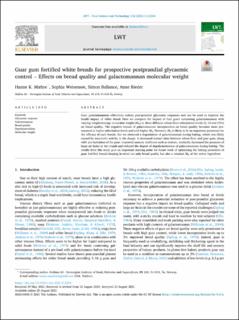| dc.contributor.author | Mæhre, Hanne K | |
| dc.contributor.author | Weisensee, Sophia | |
| dc.contributor.author | Ballance, Simon | |
| dc.contributor.author | Rieder, Anne | |
| dc.date.accessioned | 2021-09-03T08:07:47Z | |
| dc.date.available | 2021-09-03T08:07:47Z | |
| dc.date.created | 2021-09-01T13:27:57Z | |
| dc.date.issued | 2021 | |
| dc.identifier.issn | 0023-6438 | |
| dc.identifier.uri | https://hdl.handle.net/11250/2772747 | |
| dc.description.abstract | Guar galactomannans effectively reduce post-prandial glycaemic responses and can be used to improve the health impact of white bread. Here we compare the impact of four guars containing galactomannans with varying weight-average molecular weight (Mw) at three different wheat flour substitution levels (5, 10 and 15%) on bread quality. The negative impact of galactomannan incorporation on bread quality becomes more pronounced at higher substitution levels and with higher Mw. However, Mw is likely to be an important parameter for the efficacy of such breads. But we observed a degradation of galactomannan during baking, which was likely caused by enzymatic activity in the dough. A decreased contact time between wheat flour and guar gum, along with pre-hydration of the guar, improved sensory attributes such as texture, markedly decreased the presence of large air holes in the crumb and reduced the degree of depolymerisation of galactomannan during baking. The results from this study give an important starting point for future work of optimizing the baking procedure of guar fortified breads keeping in mind not only bread quality but also a retained Mw of the active ingredient. | |
| dc.language.iso | eng | |
| dc.subject | Molecular weight | |
| dc.subject | Molecular weight | |
| dc.subject | Galactomannan | |
| dc.subject | Galactomannan | |
| dc.subject | Depolymerisation | |
| dc.subject | Depolymerisation | |
| dc.subject | Glycaemic response | |
| dc.subject | Glycaemic response | |
| dc.subject | Bread quality | |
| dc.subject | Bread quality | |
| dc.title | Guar gum fortified white breads for prospective postprandial glycaemic control – Effects on bread quality and galactomannan molecular weight | |
| dc.type | Peer reviewed | |
| dc.type | Journal article | |
| dc.description.version | publishedVersion | |
| dc.source.volume | 152 | |
| dc.source.journal | Lebensmittel-Wissenschaft + Technologie | |
| dc.identifier.doi | 10.1016/j.lwt.2021.112354 | |
| dc.identifier.cristin | 1930481 | |
| dc.relation.project | Norges forskningsråd: 296083 | |
| dc.relation.project | Norges forskningsråd: 208674 | |
| dc.relation.project | Nofima AS: 202103 | |
| dc.relation.project | Norges forskningsråd: 314318 | |
| dc.relation.project | Nofima AS: 202101 | |
| dc.relation.project | Nofima AS: 201701 | |
| dc.relation.project | Norges forskningsråd: 314599 | |
| dc.relation.project | Norges forskningsråd: 262300 | |
| dc.relation.project | Nofima AS: 12970 | |
| dc.relation.project | Nofima AS: 4319 | |
| cristin.ispublished | true | |
| cristin.fulltext | original | |
| cristin.qualitycode | 1 | |
